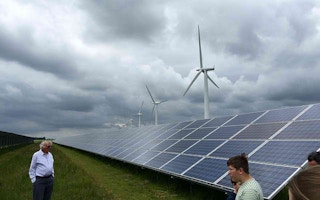The cheapest way of generating energy today is to use renewable fuels – and the authors of a new analysis predict that renewables are set to enjoy even more of an advantage within a few years.
The study by the Carbon Tracker Initiative says renewable power generation costs are already lower on average worldwide than those of fossil fuels.
It couples this with a bold claim that clean energy plants will become more cost-competitive by 2020.
The Carbon Tracker authors call for new thinking about what’s happening in the energy markets in the wake of the UN climate talks in Paris last December, which concluded the Paris Agreement on tackling climate change.
They say assuming that demand for energy from fossil fuels will remain high for years ahead could be seriously mistaken.
“
This trend is only likely to spread as the growth of renewables undermines the economics of fossil fuels.
Paul Dowling, co-author, Carbon Tracker
Outdated assumptions
James Leaton, Carbon Tracker’s head of research, says: “Policy-makers and investors really need to question outdated assumptions on technology costs that do not factor in the direction of travel post-Paris. Planning for business-as-usual load factors and lifetimes for new coal and gas plants is a recipe for stranded assets.”
The study uses a tool called a Levelised Cost of Electricity (LCOE) sensitivity analysis to compare the power-generation costs of four new-build coal, gas, wind and solar plants.
The LCOE is a way to compare different methods of electricity generation, using the average total cost to build and operate a power plant divided by its total lifetime energy output.
And the study shows that reduced load factors (measures of efficiency) and shorter lifetimes for coal and gas plants in a world that is steadily decarbonising significantly undermine the plants’ economics. It says few models so far have taken these factors into account.
At the same time, solar and wind energy can rely on lower-cost capital and cheaper technology, further improving the relative competitive position of renewables.
“This analysis explains why renewables are already the cheapest option in a number of markets,” says Paul Dowling, a co-author of the report. “This trend is only likely to spread as the growth of renewables undermines the economics of fossil fuels.”
Renewables plants
Carbon Tracker says another important point to consider is who is developing renewables plants. Developers and management funds with lower costs of capital are entering the market, bringing down LCOEs for more capital-intensive renewables.
And taking into account that renewable energy is spreading more widely, and that workers are becoming more at home with the technologies it employs, this reduces still further the capital costs of clean power plants.
The study says that, after 2020, the impetus developed by the Paris Agreement will see renewables on average more cost-competitive, even if fossil fuel prices fall and carbon prices are modest at around US$10 per tonne of CO2, or lower.
“Markets are having to deal with integrating variable renewables on a growing scale,” says Matt Gray, senior Carbon Tracker analyst and a co-author of the report.
“Rather than continue debating whether this energy transition is already occurring, it is time to focus on developing the opportunities in energy storage and demand management that can smooth the process.”
This story was published with permission from Climate News Network.










